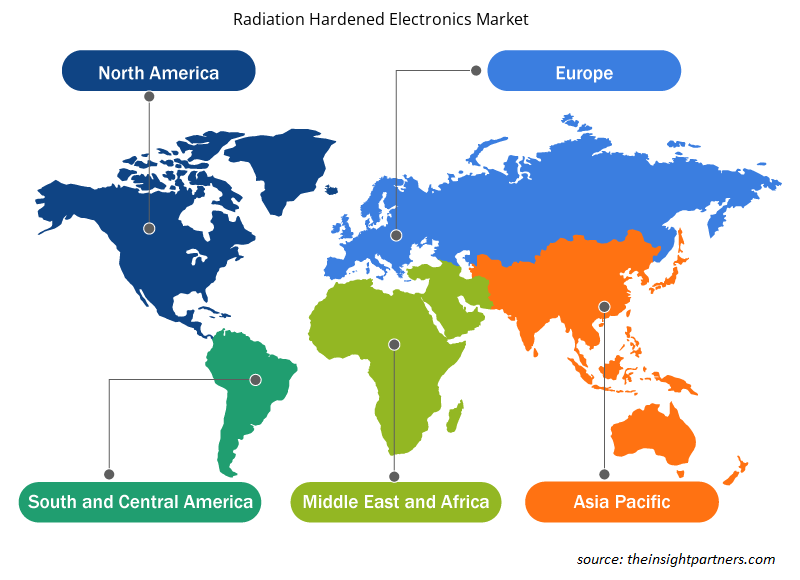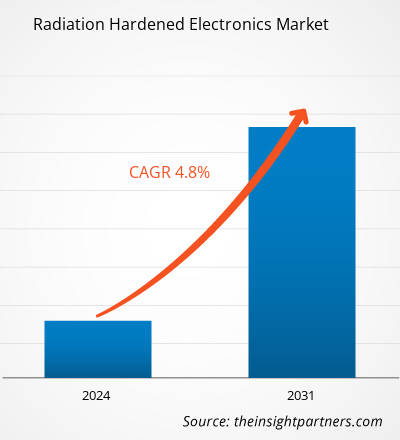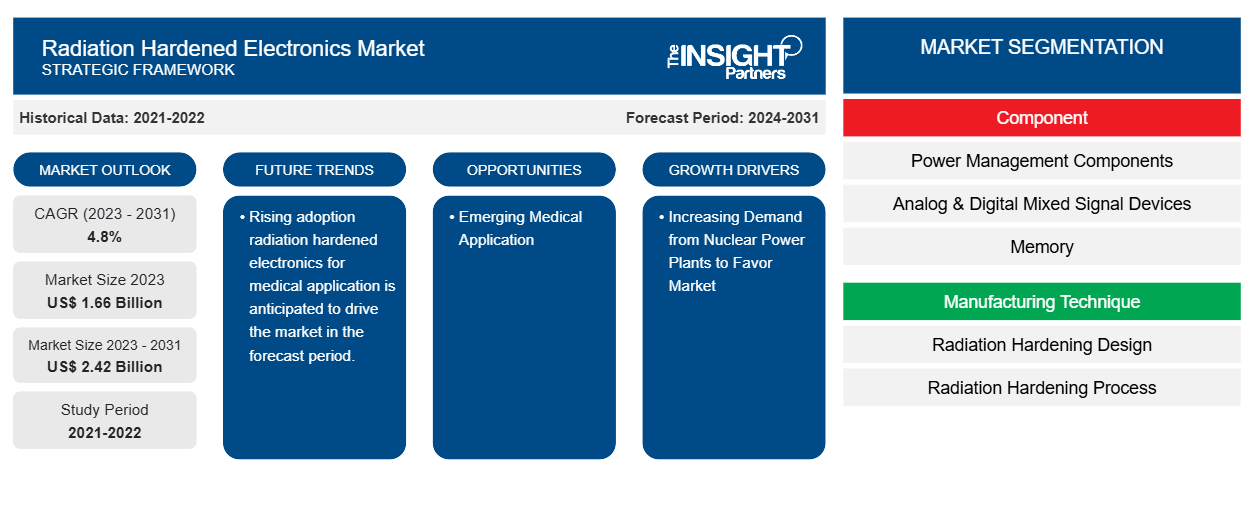La taille du marché de l’électronique durcie aux radiations devrait atteindre 2,42 milliards USD d’ici 2031, contre 1,66 milliard USD en 2023. Le marché devrait enregistrer un TCAC de 4,8 % au cours de la période 2023-2031. L’adoption croissante de l’électronique durcie aux radiations et l’augmentation des investissements dans les programmes spatiaux devraient rester des tendances et des moteurs clés du marché.CAGR of 4.8% during 2023–2031. Increasing adoption of radiation-hardened electronics and increasing investment in space programs are likely to remain key trends and drivers in the market.
Analyse du marché de l'électronique durcie aux radiations
La demande croissante de capteurs de rétroaction renforcés aux radiations parmi les fabricants d'équipements et de systèmes critiques du monde entier devrait stimuler le marché des capteurs de rétroaction renforcés aux radiations au cours de la période de prévision. Les capteurs de rétroaction renforcés aux radiations sont largement intégrés dans les systèmes aérospatiaux et de défense, les engins spatiaux, les satellites, les sondes spatiales, les équipements médicaux et autres. Les progrès technologiques, la miniaturisation des capteurs de rétroaction renforcés aux radiations, la demande croissante d'énergie renouvelable et l'augmentation des activités de R&D propulsent le marché des capteurs de rétroaction renforcés aux radiations.
Aperçu du marché de l'électronique durcie aux radiations
Les capteurs de rétroaction résistants aux radiations sont des dispositifs conçus pour résister à des niveaux de rayonnement élevés, le plus souvent rencontrés dans les environnements nucléaires et spatiaux. Ces capteurs utilisent un mécanisme de rétroaction pour surveiller en permanence leurs performances et s'ajuster en conséquence en garantissant des opérations fiables et précises en cas de rayonnements intenses. Les capteurs utilisent des boucles de rétroaction pour détecter tout écart par rapport à leur comportement attendu causé par des dommages induits par les radiations.
Personnalisez ce rapport en fonction de vos besoins
Vous bénéficierez d'une personnalisation gratuite de n'importe quel rapport, y compris de certaines parties de ce rapport, d'une analyse au niveau des pays, d'un pack de données Excel, ainsi que d'offres et de remises exceptionnelles pour les start-ups et les universités.
-
Obtenez les principales tendances clés du marché de ce rapport.Cet échantillon GRATUIT comprendra une analyse de données, allant des tendances du marché aux estimations et prévisions.
Moteurs et opportunités du marché de l'électronique renforcée contre les radiations
La demande croissante des centrales nucléaires devrait favoriser le marché
Les centrales nucléaires produisent de l'électricité par le biais du processus de fission nucléaire. Au cours de ce processus, une quantité importante d'énergie est produite, ce qui génère une quantité substantielle de rayonnement. Ce rayonnement est nocif pour l'homme et peut endommager les équipements électroniques, ce qui augmente la demande de capteurs de rétroaction résistants aux rayonnements. Des capteurs de rétroaction résistants aux rayonnements sont placés stratégiquement dans toute la centrale pour surveiller les variations de température dans les zones critiques, telles que les systèmes de refroidissement, le cœur du réacteur et divers composants. Ces capteurs fournissent une rétroaction continue aux systèmes de contrôle, permettant aux opérateurs de la centrale de prendre les mesures nécessaires pour maintenir la plage de température souhaitée et de prendre des décisions éclairées pour améliorer les performances du système. Plusieurs entreprises réalisent des investissements importants dans le développement de centrales électriques. Par exemple, selon les données du ministère américain de l'Énergie (DOE) publiées en janvier 2024, le DOE a investi environ 12 milliards de dollars américains dans la centrale Vogtle pour fournir plus de 1 100 mégawatts d'énergie propre au réseau une fois en service.Vogtle to provide more than 1,100 megawatts of clean power to the grid once in operation.
Application médicale émergente.
Les capteurs de rétroaction renforcés aux radiations jouent un rôle crucial pour garantir la sécurité, la précision et la fiabilité des équipements médicaux utilisés dans le secteur de la santé. Ces capteurs sont intégrés dans divers équipements médicaux, notamment les rayons gamma, les rayons X et les faisceaux d'électrons, en les rendant résistants à des niveaux de rayonnement élevés. Les capteurs de rétroaction renforcés aux radiations sont principalement intégrés dans les équipements de radiothérapie pour aider les médecins à traiter les patients atteints de cancer. La radiothérapie , également connue sous le nom de radiothérapie, est le mode de traitement le plus courant pour les patients atteints de cancer, où des faisceaux de rayonnement à haute énergie sont utilisés pour cibler et détruire les cellules cancéreuses, qui nécessitent des capteurs de rétroaction renforcés aux radiations pour surveiller divers paramètres, notamment la délivrance de la dose, la densité du faisceau et le positionnement du faisceau. Les professionnels de la santé utilisent des capteurs de rétroaction renforcés aux radiations pour garantir l'administration d'un traitement précis et exact en minimisant les dommages aux tissus sains. Par exemple, en avril 2022, Maxon Group a présenté les codeurs ENX GAMA conçus pour être utilisés à proximité des accélérateurs linéaires médicaux sur des équipements tels que les collimateurs multilames. Les encodeurs ENX GAMA sont des encodeurs résistants aux radiations intégrés à des moteurs à courant continu qui conviennent parfaitement aux appareils de radiothérapie.Maxon Group introduced ENX GAMA encoders designed for use in the vicinity of medical linear accelerators on equipment such as multi-leaf collimators. ENX GAMA encoders are radiation-resistant encoders integrated with DC motors that are highly suitable for radiotherapy devices.
Analyse de segmentation du rapport sur le marché de l'électronique durcie aux radiations
Les segments clés qui ont contribué à l’élaboration de l’analyse du marché de l’électronique durcie aux radiations sont les composants, la technique de fabrication et les applications.
- En fonction des composants, le marché de l'électronique durcie aux radiations est divisé en composants de gestion de l'alimentation, dispositifs à signaux mixtes analogiques et numériques, mémoire et contrôleurs et processeurs. Le segment des composants de gestion de l'alimentation devrait détenir une part de marché importante au cours de la période de prévision.
- En fonction de la technique de fabrication, le marché de l'électronique durcie aux radiations est divisé en deux catégories : le durcissement par rayonnement par conception (RHBD) et le durcissement par rayonnement par procédé (RHBP). Le segment du durcissement par rayonnement par conception (RHBD) devrait détenir une part de marché importante au cours de la période de prévision.
- En termes d'applications, le marché est segmenté en aérospatiale et défense, centrale nucléaire, espace et autres. L'aérospatiale et la défense devraient détenir une part de marché significative au cours de la période de prévision.
Analyse des parts de marché de l'électronique durcie aux radiations par zone géographique
La portée géographique du rapport sur le marché de l’électronique durcie aux radiations est principalement divisée en cinq régions : Amérique du Nord, Asie-Pacifique, Europe, Moyen-Orient et Afrique, et Amérique du Sud et centrale.
L'Amérique du Nord domine le marché de l'électronique durcie aux radiations. L'expansion de l'industrie spatiale stimule le marché des capteurs de rétroaction durcis aux radiations en Amérique du Nord. Les États-Unis sont à l'avant-garde des vols spatiaux depuis plus de 60 ans. Ils possèdent le plus grand programme spatial gouvernemental au monde. Les satellites enregistrés aux États-Unis représentaient plus de la moitié de tous les satellites opérationnels en 2022. Les États-Unis sont actuellement le seul pays à disposer d'un compte thématique pour les activités spatiales. De plus, l'accent mis sur la recherche et le développement dans les économies développées des États-Unis et du Canada oblige les acteurs nord-américains à apporter des solutions technologiquement avancées sur le marché. En outre, les États-Unis comptent un grand nombre d'acteurs du marché de l'électronique durcie aux radiations qui se concentrent de plus en plus sur le développement de solutions innovantes. Tous ces facteurs contribuent à la croissance du marché de l'électronique durcie aux radiations dans la région.
Aperçu régional du marché de l'électronique durcie aux radiations
Les tendances et facteurs régionaux influençant le marché de l’électronique renforcée aux radiations tout au long de la période de prévision ont été expliqués en détail par les analystes d’Insight Partners. Cette section traite également des segments et de la géographie du marché de l’électronique renforcée aux radiations en Amérique du Nord, en Europe, en Asie-Pacifique, au Moyen-Orient et en Afrique, ainsi qu’en Amérique du Sud et en Amérique centrale.

- Obtenez les données régionales spécifiques au marché de l'électronique durcie aux radiations
Portée du rapport sur le marché de l'électronique durcie aux radiations
| Attribut de rapport | Détails |
|---|---|
| Taille du marché en 2023 | 1,66 milliard de dollars américains |
| Taille du marché d'ici 2031 | 2,42 milliards de dollars américains |
| Taux de croissance annuel composé mondial (2023-2031) | 4,8% |
| Données historiques | 2021-2022 |
| Période de prévision | 2024-2031 |
| Segments couverts |
Par composant
|
| Régions et pays couverts |
Amérique du Nord
|
| Leaders du marché et profils d'entreprises clés |
|
Densité des acteurs du marché : comprendre son impact sur la dynamique des entreprises
Le marché de l'électronique durcie aux radiations connaît une croissance rapide, tirée par la demande croissante des utilisateurs finaux en raison de facteurs tels que l'évolution des préférences des consommateurs, les avancées technologiques et une plus grande sensibilisation aux avantages du produit. À mesure que la demande augmente, les entreprises élargissent leurs offres, innovent pour répondre aux besoins des consommateurs et capitalisent sur les tendances émergentes, ce qui alimente davantage la croissance du marché.
La densité des acteurs du marché fait référence à la répartition des entreprises ou des sociétés opérant sur un marché ou un secteur particulier. Elle indique le nombre de concurrents (acteurs du marché) présents sur un marché donné par rapport à sa taille ou à sa valeur marchande totale.
Les principales entreprises opérant sur le marché de l'électronique renforcée aux radiations sont :
- Systèmes BAE
- Société de périphériques de données
- Honeywell International Inc.
- Infineon Technologies AG
- Société de Renesas Electronics
- Texas Instruments Incorporated
Avis de non-responsabilité : les sociétés répertoriées ci-dessus ne sont pas classées dans un ordre particulier.

- Obtenez un aperçu des principaux acteurs du marché de l'électronique durcie aux radiations
Actualités et développements récents du marché de l'électronique durcie aux radiations
Le marché de l'électronique durcie aux radiations est évalué en collectant des données qualitatives et quantitatives après des recherches primaires et secondaires, qui comprennent d'importantes publications d'entreprise, des données d'association et des bases de données. Quelques-uns des développements du marché de l'électronique durcie aux radiations sont répertoriés ci-dessous :
- EPC Space a présenté l'EPC7009L16SH, un circuit intégré de commande de grille en nitrure de gallium (GaN) durci aux radiations. Utilisant la technologie exclusive eGaN IC d'EPC, ce pilote GaN innovant permet aux ingénieurs concepteurs d'exploiter pleinement les capacités de la technologie eGaN FET. (Source : EPC Space, site Web de l'entreprise, avril 2024)
- Renesas Electronics Corporation, fournisseur de solutions avancées de semi-conducteurs, a lancé une nouvelle gamme de dispositifs durcis aux radiations (rad-hard) sous emballage plastique pour les systèmes de gestion de l'alimentation des satellites. Les quatre nouveaux dispositifs comprennent le régulateur abaisseur de point de charge (POL) ISL71001SLHM/SEHM, les isolateurs numériques ISL71610SLHM et ISL71710SLHM, ainsi que le FET GaN 100 V ISL73033SLHM et le pilote côté bas intégré. (Source : Renesas Electronics Corporation, site Web de la société, juillet 2021)
Rapport sur le marché de l'électronique durcie aux radiations et livrables
Le rapport « Taille et prévisions du marché de l’électronique durcie aux radiations (2021-2031) » fournit une analyse détaillée du marché couvrant les domaines ci-dessous :
- Taille et prévisions du marché de l’électronique durcie aux radiations aux niveaux mondial, régional et national pour tous les segments de marché clés couverts dans le cadre.
- Tendances du marché de l’électronique renforcée aux radiations ainsi que la dynamique du marché telles que les moteurs, les contraintes et les opportunités clés.
- Analyse détaillée des cinq forces de PEST/Porter et SWOT.
- Analyse du marché de l’électronique renforcée aux radiations couvrant les principales tendances du marché, le cadre mondial et régional, les principaux acteurs, les réglementations et les développements récents du marché.
- Analyse du paysage industriel et de la concurrence couvrant la concentration du marché, l'analyse de la carte thermique, les principaux acteurs et les développements récents pour le marché de l'électronique durcie aux radiations.
- Profils d'entreprise détaillés.
- Analyse historique (2 ans), année de base, prévision (7 ans) avec TCAC
- Analyse PEST et SWOT
- Taille du marché Valeur / Volume - Mondial, Régional, Pays
- Industrie et paysage concurrentiel
- Ensemble de données Excel
Rapports récents
Témoignages
Raison d'acheter
- Prise de décision éclairée
- Compréhension de la dynamique du marché
- Analyse concurrentielle
- Connaissances clients
- Prévisions de marché
- Atténuation des risques
- Planification stratégique
- Justification des investissements
- Identification des marchés émergents
- Amélioration des stratégies marketing
- Amélioration de l'efficacité opérationnelle
- Alignement sur les tendances réglementaires























 Obtenez un échantillon gratuit pour - Marché de l'électronique durcie aux radiations
Obtenez un échantillon gratuit pour - Marché de l'électronique durcie aux radiations